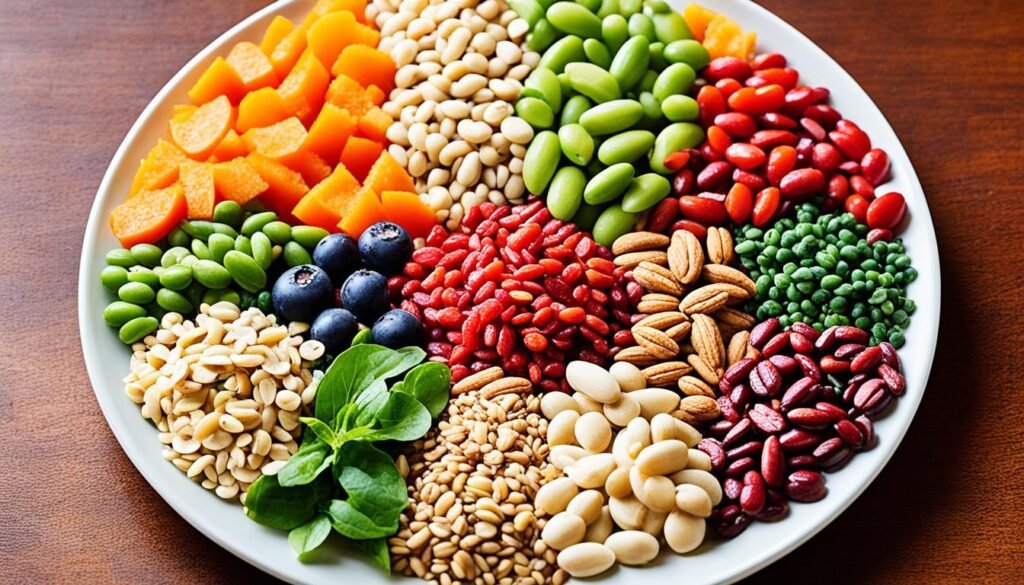As a busy professional, I know how key it is to keep our digestive systems healthy. That’s why I’m thrilled to share 5 tasty, high-fiber recipes for your meal prep. These recipes focus on fiber-rich foods to help boost your gut health and digestion. By planning your meals with fiber in mind, you can take charge of your digestive wellness and enjoy the perks of a high-fiber diet.
Key Takeaways
- Discover 5 nutrient-dense, high-fiber recipes to improve digestion
- Learn how to boost gut health through strategic meal planning
- Understand the importance of dietary fiber for overall wellness
- Explore whole food, plant-based ingredients to incorporate into your meals
- Gain tips for gradually increasing fiber intake and relieving digestive issues
Introduction to Fiber-Rich Meal Planning
Dietary fiber is key to a healthy diet. It’s mainly found in plant-based foods. Fiber helps keep your gut and digestion healthy. Adding more high-fiber foods to your meals can greatly benefit your health.
The Importance of Dietary Fiber
Fiber is the part of plants we can’t digest. It moves through our digestive system. It offers many health benefits, like helping with bowel movements and supporting good gut bacteria.
Benefits of a High-Fiber Diet
- Improved digestion and regularity
- Enhanced nutrient absorption
- Reduced risk of chronic diseases, such as heart disease and type 2 diabetes
- Stabilized blood sugar levels
- Increased feelings of fullness and satiety, which can aid in weight management
Choosing high-fiber diets supports your gut health and overall well-being. It helps you enjoy nutritious and fulfilling meals for life.
“Fiber is the unsung hero of the nutrient world, quietly working behind the scenes to keep our digestive system running smoothly and our overall health in check.”
Meal Prep Tips for Boosting Fiber Intake
I know how vital it is to eat more fiber. It’s good for your gut and keeps you feeling full. That’s why I’ve found easy ways to add more fiber to my meals every day.
I always have fiber-rich foods like oats, lentils, berries, and leafy greens on hand. These foods are packed with nutrients and fiber. They make my meals fiber-rich, keeping me full and healthy.
I also like to get creative with how I cook. Roasting veggies like Brussels sprouts, carrots, and cauliflower makes them sweet and fiber-rich. Blending fruits and veggies into smoothies is another quick way to start my day with fiber.
- Incorporate whole grains like quinoa, brown rice, and whole wheat bread into your meals.
- Experiment with high-fiber legumes such as lentils, beans, and chickpeas.
- Snack on nuts, seeds, and dried fruit to boost your fiber intake throughout the day.
These easy changes to my meal prep have helped me eat more fiber. Small changes can really improve your health and happiness.
Fiber-Focused Meal Prep: 5 High-Fiber Recipes for Improved Digestion
Recipe 1: Overnight Oats with Chia Seeds
Start your day with a breakfast full of fiber. Our Overnight Oats with Chia Seeds recipe is great for your digestive health. It’s easy to make ahead and combines whole grains and superfoods for energy and fullness.
Oats are packed with soluble fiber, helping your digestion and gut health. Chia seeds add more fiber, making your breakfast both nutritious and tasty. These ingredients together make a fiber-rich meal that’s simple to prepare and enjoyable to eat.
- In a mason jar or airtight container, combine 1/2 cup rolled oats, 1 tablespoon chia seeds, 1 cup unsweetened almond milk, 1 teaspoon honey, and a pinch of cinnamon.
- Stir until well combined, then cover and refrigerate overnight.
- In the morning, top your Overnight Oats with fresh berries, sliced almonds, or a drizzle of peanut butter for an extra boost of fiber and flavor.
This breakfast gives you about 10 grams of fiber per serving. It’s a great way to start your day with fiber. Enjoy it as part of your meal prep for better digestion and health.

High-Fiber Ingredients to Stock Up On
Building a high-fiber diet means having the right ingredients ready. Whole grains, legumes, and fiber-rich produce are key. They make meal prep easy and help your body get the fiber it needs.
Whole Grains
Whole grains are full of fiber and can spice up your meals. Think oats, quinoa, brown rice, whole wheat bread and pasta, and farro. These foods are not just high in fiber. They also offer complex carbs, protein, and important vitamins and minerals.
Legumes
Legumes like lentils, chickpeas, black beans, and kidney beans add fiber to any meal. They fit well in soups, stews, salads, and even plant-based burgers. Legumes help with digestion and can aid in weight management.
Fruits and Vegetables
Fruits and vegetables are packed with fiber and offer many flavors and nutrients. Top choices include berries, pears, apples, broccoli, Brussels sprouts, artichokes, and dark leafy greens. Adding these to your meals can greatly increase your fiber intake.
With these high-fiber ingredients, you can make tasty, nutritious meals. They support your digestive health and overall well-being.
Balancing Fiber-Rich Meals
Getting the right amount of fiber is key for good gut health and digestion. High-fiber diets have many benefits. But, it’s important to balance different fibers for your body to use and absorb them well.
Soluble fiber is in foods like oats, beans, and berries. It helps with bowel movements and lowers cholesterol. Insoluble fiber is in whole grains and veggies. It makes stool bulkier and helps with regular bowel movements. Eating a mix of fiber-rich foods helps you get the most from a plant-based diet.
Here are some tips for balancing fiber-rich meals:
- Combine soluble and insoluble fiber sources in each meal, such as pairing brown rice (insoluble) with lentils (soluble).
- Include a variety of high-fiber fruits and vegetables, such as berries, broccoli, and artichokes, to ensure a diverse array of fiber types.
- Choose whole grains over refined options, like swapping white bread for whole wheat or opting for quinoa instead of white rice.
- Incorporate nuts, seeds, and legumes, which are excellent sources of both soluble and insoluble fiber.
Pay attention to your fiber intake and balance different fiber sources. This supports a healthy gut and digestive wellness. Start slowly adding more fiber to avoid discomfort.
“A balanced fiber intake is the key to a happy, healthy gut.”
Strategies for Increasing Fiber Gradually
Switching to a high-fiber diet can greatly improve your gut health and digestion. But, it’s important to do it the right way. Jumping into it too fast can cause side effects, so start slow and steady.
Start Slow and Steady
It’s key to increase your fiber intake gradually. Start by adding a few more servings of whole grains, fruits, and veggies to your meals. This helps your body adjust, reducing the chance of bloating or discomfort. Aim to get to 25-30 grams of fiber a day slowly, for a smooth move to a high-fiber diet.
Stay Hydrated
Drinking enough water is vital when you’re eating more dietary fiber. Fiber pulls in water in your gut, and not enough fluids can cause constipation. Drink lots of water all day, and try adding in hydrating, fiber-rich foods like chia seeds, berries, and leafy greens to your meals.
By starting slow and drinking plenty of water, you can easily add more high-fiber foods to your diet. This leads to better gut health and constipation relief. Remember, making small, lasting changes is the best way to keep your digestion healthy.

Incorporating Fiber into Every Meal
Getting enough dietary fiber every day is crucial for good health. By adding fiber-rich foods to your meals, you can easily increase your fiber intake. This supports a diet based on plants and offers many health benefits. Here are some easy ways to make fiber a key part of your meals.
Start the Day Strong with Fiber-Packed Breakfasts
Begin your day with a breakfast full of fiber to stay full and energized. Choose whole grain cereals, oatmeal, or overnight oats with chia seeds. Add fresh berries, sliced almonds, or ground flaxseed on top for more fiber.
Fiber-Filled Lunches and Dinners
For your main meals, focus on high-fiber whole foods. Use plant-based proteins like lentils, chickpeas, or black beans. Add fiber-rich veggies like broccoli, spinach, or sweet potatoes. Whole grain breads, brown rice, or quinoa also add to a fiber-rich meal.
Snack Smart with Fiber-Fueled Treats
Choose snacks high in fiber to keep you full between meals. Go for fresh fruit, raw veggies with hummus, or nuts and seeds. You can also try a fiber-rich energy bar or Greek yogurt with berries and chia or flax.
Making fiber a key part of every meal helps you meet your daily fiber needs. It supports your health and digestion. Try new recipes and ingredients to keep your meals interesting and healthy.
| Fiber-Rich Ingredients | Fiber Content (per serving) |
|---|---|
| Oats (1 cup, cooked) | 4 grams |
| Lentils (1 cup, cooked) | 15 grams |
| Broccoli (1 cup, raw) | 2.4 grams |
| Chia seeds (2 tablespoons) | 10 grams |
| Raspberries (1 cup) | 8 grams |
Tackling Digestive Issues with Fiber
If you’ve been dealing with digestive problems like constipation, a high-fiber diet might help. Fiber is key for a healthy gut and regular bowel movements. Adding more fiber-rich foods to your meals can ease your digestive troubles and boost your health.
Relieving Constipation
A high-fiber diet can help with constipation. Fiber makes your stool bulkier, making it easier to pass through your system. It also draws water into your intestines, making the stool softer and more lubricated. This can ease constipation and make bowel movements more regular and comfortable.
Promoting Gut Health
A fiber-rich diet does more than just help with constipation. It also supports a healthy gut microbiome. Fiber acts as a prebiotic, feeding the good bacteria in your gut. These bacteria are vital for digestion, absorbing nutrients, and keeping your immune system strong. Eating a variety of high-fiber foods can help your gut flora grow and become more diverse, improving your gut health.
| High-Fiber Foods | Fiber Content (per serving) |
|---|---|
| Lentils | 15 grams |
| Raspberries | 8 grams |
| Oats | 4 grams |
| Broccoli | 3 grams |
| Chia Seeds | 10 grams |
Adding more high-fiber foods to your meals is a great way to tackle digestive issues and support gut health. Start by adding a little more fiber each day and drink plenty of water to help it work its best.
“Fiber is the foundation of a healthy digestive system. By making it a priority in your meal planning, you can find relief from common issues and support your overall well-being.”
Plant-Based Meal Prep for Fiber Boost
I’ve learned a lot about dietary fiber in this article. I see now how eating more plant-based foods can help. These foods are full of fiber and nutrients, which is good for my digestive health.
Adding more plant-based meals to my weekly prep has changed everything. I now enjoy dishes like lentil stews and salads full of vegetables. These foods make me feel full and give me lots of energy.
My pantry is full of whole grains, legumes, and fresh produce. This makes it easy to make healthy, fiber-rich meals. I’m loving the variety of plant-based meals I can make.
This way of meal prepping fits perfectly with what I’ve learned in this article. By eating more fiber, drinking plenty of water, and balancing my meals, I’ve seen big improvements in my digestion. I’m excited to try new recipes and find ways to eat more fiber through my meal prep.



